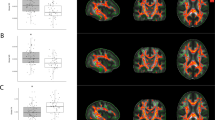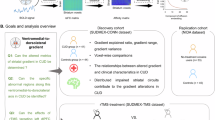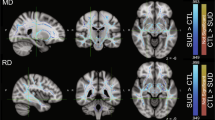Abstract
We evaluated the hypothesis that ventricular and cortical CSF volume increases are associated with reductions in the magnitude of euphoric effects produced by intravenous IV cocaine infusion in cocaine dependent (CD) individuals. Eleven CD patients participating in a cocaine-infusion study and eleven control subjects underwent magnetic resonance imaging (MRI). Two CSF regions of interest (lateral ventricles and frontal cortex CSF) and two comparison regions (third ventricle and posterior cortex CSF) were measured. Self-reported ratings of the intensity of euphoric response (“high”) were obtained from the CD subjects at 3, 10, and 30 minutes after IV administration of cocaine. A significant negative correlation was observed between the volume of the lateral ventricles and subjective ratings of the “high” experienced at 3 minutes, but not at 10 and 30 minutes after cocaine infusion. In contrast, a significant negative correlation between frontal cortex CSF volume and the intensity of euphoric response was observed at 30 minutes after IV cocaine. No significant associations were observed between the volumes of the two comparison regions and any subjective ratings of “high.” No significant volume differences were observed between the CD and control groups in any region. The results suggest larger lateral ventricular volumes are associated with a decrease in immediate euphoria while larger frontal cortex CSF volumes are associated with a decrease in the duration of the euphoria induced by cocaine infusion. The age-related brain volume reductions underlying the volume increase in these two CSF spaces may be the neurobiological basis of the age-related reduction in the rates of addiction.
Similar content being viewed by others
Log in or create a free account to read this content
Gain free access to this article, as well as selected content from this journal and more on nature.com
or
References
Bartzokis G, Beckson M, Newton T, Mandelkern M, Foster JA, Ling W, Bridge P . (1999a): Selegiline effects on cocaine-induced changes in medial temporal lobe metabolism and subjective ratings of euphoria. Neuropsychopharmacology 20: 582–590
Bartzokis G, Beckson M, Hance DB, Lu PH, Foster JA, Mintz J, Ling W, Bridge P . (1999b): MRI evidence of “silent” neurovascular toxicity in cocaine dependence. Biol Psychiatry 45: 1203–1211
Bartzokis G, Beckson M, Lu PH, Edwards N, Rapoport R, Wiseman E, Bridge P . (2000): Age-related brain volume reductions in amphetamine and cocaine addicts and normal controls: implications for addiction research. Psychiatry Res: Neuroimaging 98: 93–102
Bartzokis G, Beckson M, Wirshing DA, Lu PH, Foster JA, Mintz J . (1999c): Choreoathetoid movements in cocaine dependence. Biol Psychiatry 45: 1630–1635
Bartzokis G, Mintz J, Marx P, Osborn D, Gutkind D, Chiang F, Phelan CK, Marder SR . (1993): Reliability of in vivo volume measures of hippocampus and other brain structures using MRI. Magn Reson Imaging 11: 993–1006
Coffey CE, Wilkinson WE, Parashos IA, Soady SA, Sullivan RJ, Patterson LJ, Figiel GS, Webb MC, Spritzer CE, Djang WT . (1992): Quantitative cerebral anatomy of the aging human brain: a cross-sectional study using magnetic resonance imaging. Neurology 42: 527–536
Cook R, Harrell A . (1987): Drug abuse among working adults: Prevalence rates and recommended strategies. Health Education Research: Theory and Practice 2: 353–359
Facy F, Rosch D, Angel P, Touzeau D, Cordonnier JP, Petit F . (1991): Drug addicts attending specialised institutions: Towards a drug addiction data bank? Drug Alcohol Depend 27: 43–50
Gottfries CG, Adolfsson R, Aquilonius SM, Carlsson A, Eckernas SA, Nordberg A, Oreland L, Svennerholm L, Wilberg A, Winblad B . (1983): Biochemical changes in dementia disorders of Alzheimer type (AD/SDAT). Neurobiol Aging 4: 261–271
Hitri A, Casanova MF, Kleinman JE, Wyatt RJ . (1994): Fewer dopamine transporter receptors in the prefrontal cortex of cocaine users. Am J Psychiatry 151: 1074–1076
Jernigan TL, Press GA, Hesselink JR . (1990): Methods for measuring brain morphologic features on magnetic resonance images. Validation and normal aging. Arch Neurol 47: 27–32
Lepage L, Schiele F, Gueguen R, Siest G . (1985): Total cholinesterase in plasma: biological variations and reference limits. Clin Chem 31: 546–550
Lim KO, Zipursky RB, Watts MC, Pfefferbaum A . (1992): Decreased gray matter in normal aging: An in vivo magnetic resonance study. J Gerontol 47: B26–30
Little KY, Patel UN, Clark TB, Butts JD . (1996): Alteration of brain dopamine and serotonin levels in cocaine users: a preliminary report. Am J Psychiatry 153: 1216–1218
Liu X, Matochik JA, Cadet JL, London ED . (1998): Smaller volume of prefrontal lobe in polysubstance abusers: a magnetic resonance imaging study. Neuropsychopharmacology 18: 243–252
Matsumae M, Kikinis R, Morocz IA, Lorenzo AV, Sandor T, Albert MS, Black PM, Jolesz FA . (1996): Age-related changes in intracranial compartment volumes in normal adults assessed by magnetic resonance imaging. J Neurosurg 84: 982–991
Miller NS . (1991): Alcohol and drug dependence. In Sadavoy J, Lazarus LW, Jarvik LF (eds), Comprehensive Review of Geriatric Psychiatry. Washington, DC, American Psychiatric Press, pp 387–401
Morgan MJ, Cascella NG, Stapleton JM, Phillips RL, Yung BC, Wong DF, Shaya EK, London ED . (1993): Sensitivity to subjective effects of cocaine in drug abusers: relationship to cerebral ventricle size. Am J Psychiatry 150: 1712–1717
Pfefferbaum A, Mathalon DH, Sullivan EV, Rawles JM, Zipursky RB, Lim KO . (1994): A quantitative magnetic resonance imaging study of changes in brain morphology from infancy to late adulthood. Arch Neurol 51: 874–887
Pfefferbaum A, Sullivan EV, Rosenbloom MJ, Mathalon DH, Lim KO . (1998): A controlled study of cortical gray matter and ventricular changes in alcoholic men over a 5-year interval. Arch Gen Psychiatry 55: 905–912
Raz N, Gunning-Dixon FM, Head D, Dupuis JH, Acker JD . (1998): Neuroanatomical correlates of cognitive aging: evidence from structural magnetic resonance imaging. Neuropsychology 12: 95–114
Strickland TL, Mena I, Villanueva-Meyer J, Miller BL, Cummings J, Mehringer CM, Satz P, Myers H . (1993): Cerebral perfusion and neuropsychological consequences of chronic cocaine use. J Neuropsychiatry Clin Neurosci 5: 419–427
Sullivan EV, Marsh L, Mathalon DH, Lim KO, Pfefferbaum A . (1995): Age-related decline in MRI volumes of temporal lobe gray matter but not hippocampus. Neurobiol Aging 16: 591–606
Tumeh SS, Nagel JS, English RJ, Moore M, Holman BL . (1990): Cerebral abnormalities in cocaine abusers: demonstration by SPECT perfusion brain scintigraphy. Work in progress. Radiology 176: 821–824
Volkow ND, Hitzemann R, Wang GJ, Fowler JS, Wolf AP, Dewey SL, Handlesman L . (1992): Long-term frontal brain metabolic changes in cocaine abusers. Synapse 11: 184–190
Wahlund LO, Agartz I, Almqvist O, Basun H, Forssell L, Saaf J, Wetterberg L . (1990): The brain in healthy aged individuals: MR imaging. Radiology 174: 675–679
Wang GJ, Volkow ND, Fowler JS, Logan J, Gur R, Netusil N, Hitzemann RJ, Pappas NS . (1996): Age associated decrements in dopamine D2 receptors in thalamus and in temporal insula of human subjects. Life Sci 59: PL31–PL35
Acknowledgements
The work was supported by the Medication Development Division of the National Institute on Drug Abuse (1YO1 DA 50038), the Research and Psychiatry Services of the Department of Veterans Affairs, and the Marie Wilson Howells Endowment. The authors thank Tom Newton, M.D., for directing the cocaine infusion laboratory, Horst Meissner, M.D., Michael Goldman, M.D., Sc.D., and Jill Tureaud, R.N., for medical screening and monitoring the cocaine infusion: Judith Lindholm, M.S., for coordinating patient recruitment, Yolanda Griffin, for technical assistance, and Marguerite Callinan, M.A., for coordinating the imaging sessions.
Author information
Authors and Affiliations
Corresponding author
Rights and permissions
About this article
Cite this article
Bartzokis, G., Beckson, M., Lu, P. et al. Increased CSF Volumes Are Associated with Diminished Subjective Responses to Cocaine Infusion. Neuropsychopharmacol 23, 468–473 (2000). https://doi.org/10.1016/S0893-133X(00)00122-6
Received:
Revised:
Accepted:
Issue date:
DOI: https://doi.org/10.1016/S0893-133X(00)00122-6



